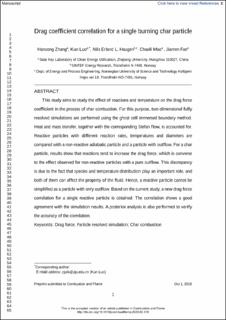| dc.contributor.author | Zhang, Hancong | |
| dc.contributor.author | Luo, Kun | |
| dc.contributor.author | Haugen, Nils Erland L | |
| dc.contributor.author | Mao, Chaoli | |
| dc.contributor.author | Fan, Jianren | |
| dc.date.accessioned | 2020-09-08T09:39:03Z | |
| dc.date.available | 2020-09-08T09:39:03Z | |
| dc.date.created | 2020-05-04T12:20:21Z | |
| dc.date.issued | 2020 | |
| dc.identifier.citation | Combustion and Flame. 2020, 217 (July), 188-199. | en_US |
| dc.identifier.issn | 0010-2180 | |
| dc.identifier.uri | https://hdl.handle.net/11250/2676825 | |
| dc.description.abstract | Fully-resolved simulations of a burning char particle are performed to understand the effects of chemical reastions on the drag force by using the ghost cell immersed boundary method. The momentum, heat and mass transfers at the interface are all considered. Reactive particle with different reaction rates, temperatures and diameters are simulated and compared with a non-reactive adiabatic particle and a particle with an outflow. The results show that both the heterogeneous reactions and the gaseous reactions increase the drag force, which is converse to the effect observed for a non-reactive particle with a pure outflow. This difference indicates that the species and temperature distributions caused by the chemical reactions around the particle play an important role in shaping the drag force. To consider these effects, the Stefan flow Reynolds number and the non-dimensional gaseous reaction rate are introduced to formulate a new drag force correlation for a burning particle based on the fully-resolved simulations. Good performance of the correlation has been demonstrated in the current conditions, and more evaluation might be required for future work. © 2020 | en_US |
| dc.language.iso | eng | en_US |
| dc.publisher | Elsevier | en_US |
| dc.rights | Attribution-NonCommercial-NoDerivatives 4.0 Internasjonal | * |
| dc.rights.uri | http://creativecommons.org/licenses/by-nc-nd/4.0/deed.no | * |
| dc.title | Drag force for a burning particle | en_US |
| dc.type | Peer reviewed | en_US |
| dc.type | Journal article | en_US |
| dc.description.version | acceptedVersion | en_US |
| dc.source.pagenumber | 188-199 | en_US |
| dc.source.volume | 217 | en_US |
| dc.source.journal | Combustion and Flame | en_US |
| dc.source.issue | July | en_US |
| dc.identifier.doi | 10.1016/j.combustflame.2020.02.016 | |
| dc.identifier.cristin | 1809213 | |
| dc.relation.project | EC/H2020/764697 | en_US |
| dc.description.localcode | © 2020. This is the authors’ accepted and refereed manuscript to the article. Locked until 27.04.2022 due to copyright restrictions. This manuscript version is made available under the CC-BY-NC-ND 4.0 license http://creativecommons.org/licenses/by-nc-nd/4.0/ | en_US |
| cristin.ispublished | true | |
| cristin.fulltext | postprint | |
| cristin.qualitycode | 2 | |

